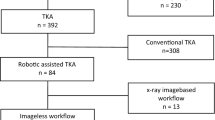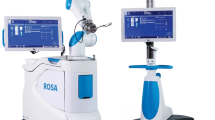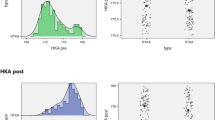Abstract
Introduction
Technological advances alongside increased demand for knee replacement surgery have led to the development of a novel image-free bed rail-mounted robotic-assisted system for total knee arthroplasty (TKA). The device is capable of real-time tracking to accommodate for leg motion during bone resection allowing for precise control and positioning of the bone saw in the planned resection plane. The purpose of this study is to discuss the versatility and accuracy of this novel image-free robotic-assisted technology in TKA.
Methods and materials
The novel robotic-assisted system underwent a stepwise assessment to verify its versatility and accuracy. First, functional accuracy was bench tested to evaluate predetermined surgical plans independent of user variability and anatomic variability compared to conventional instrumentation. This was followed by assessments utilizing cadaveric specimens for resection accuracy, implant positioning, and soft tissue involvement.
Results
Test bench accuracy revealed overall pooled linear positional accuracy of 0.326 ± 0.249 mm and pooled angular positional accuracy of 0.365 ± 0.611°. Resection errors for both robotic and conventional cohorts ranged between 0.6° and 1.9°. Concerning coronal alignment, 33/40 robotic specimen were within ± 1° and 38/40 within ± 3° of the femoral varus–valgus target, compared with 17/40 and 37/40 with conventional instrumentation, respectively. Twenty-four of the 40 robotic specimens were within ± 1° and 40/40 within ± 3° of the tibial varus–valgus target compared with 15/40 and 32/40 with conventional instrumentation, respectively. Soft tissue structures were uncompromised in all robotic-assisted cases. Conventional instruments revealed two cases of partial cleavage of the posterior cruciate ligament and two instances of a compromised posterior medial capsule. There were no significant differences between the two techniques concerning the samples that were uncompromised and fully functional (40/40 vs. 38/40, p = 0.49).
Conclusion
The novel image-free robotic-assisted surgical system demonstrates excellent benchtop accuracy to aid bony resection in cadaveric specimens. It offers notable improvement in coronal implant alignment compared to conventional instrumentation.







Similar content being viewed by others
References
Klug A, Gramlich Y, Rudert M et al (2020) The projected volume of primary and revision total knee arthroplasty will place an immense burden on future heath care systems over the next 30 years. Knee Surgery Sport Traumatol Arthrosc. https://doi.org/10.1007/s00167-020-06154-7
Sloan M, Premkumar A, Sheth NP (2018) Projected volume of primary total joint arthroplasty in the U.S., 2014 to 2030. J Bone Jt Surg 100:1455–1460. https://doi.org/10.2106/JBJS.17.01617
Patel A, Pavlou G, Mújica-Mota RE, Toms AD (2015) The epidemiology of revision total knee and hip arthroplasty in England and Wales: a comparative analysis with projections for the United States. A study using the national joint registry dataset. Bone Jt J. https://doi.org/10.1302/0301-620X.97B8.35170
Donaldson J, Joyner J, Tudor F (2015) Current controversies of alignment in total knee replacements. Open Orthop J 9:489–494. https://doi.org/10.2174/1874325001509010489
Price AJ, Alvand A, Troelsen A et al (2018) Knee replacement. Lancet
Kayani B, Haddad FS (2019) Robotic total knee arthroplasty: clinical outcomes and directions for future research. Bone Joint Res 8:438–442. https://doi.org/10.1302/2046-3758.810.BJR-2019-0175
Petrie JR, Haidukewych GJ (2016) Instability in total knee arthroplasty assessment and solutions. Bone Jt J. https://doi.org/10.1302/0301620X.98B1.36371
Allen MM, Pagnano MW (2016) Neutral mechanical alignment: Is it necessary? Bone Jt J 98:81–83. https://doi.org/10.1302/0301-620X.98B1.36403
Huang T, Long Y, George D, Wang W (2017) Meta-analysis of gap balancing versus measured resection techniques in total knee arthroplasty. Bone Jt J. https://doi.org/10.1302/0301-620X.99B2.BJJ-2016-0042.R2
Kayani B, Konan S, Ayuob A et al (2019) Robotic technology in total knee arthroplasty: a systematic review. EFORT Open Rev 4:611–617. https://doi.org/10.1302/2058-5241.4.190022
Khan M, Osman K, Green G, Haddad FS (2016) The epidemiology of failure in total knee arthroplasty avoiding your next revision. Bone Jt J. https://doi.org/10.1302/0301620X.98B1.36293
Basselot F, Gicquel T, Common H et al (2016) Are ligament-tensioning devices interchangeable? A study of femoral rotation. Orthop Traumatol Surg Res 2:2. https://doi.org/10.1016/j.otsr.2016.02.001
Teter KE, Bregman D, Colwell CW (1995) Accuracy of intramedullary versus extramedullary tibial alignment cutting systems in total knee arthroplasty. In: Clinical Orthopaedics and Related Research
Singh V, Fiedler B, Simcox T et al (2020) Does the use of intraoperative technology yield superior patient outcomes following total knee arthroplasty? J Arthroplasty. https://doi.org/10.1016/j.arth.2020.11.001
Ren Y, Cao S, Wu J, et al (2019) Efficacy and reliability of active robotic-assisted total knee arthroplasty compared with conventional total knee arthroplasty: A systematic review and meta-analysis. Postgrad Med J
Tabatabaee RM, Rasouli MR, Maltenfort MG et al (2018) Computer-assisted total knee arthroplasty: is there a difference between image-based and imageless techniques? J Arthroplasty. https://doi.org/10.1016/j.arth.2017.11.030
Jacofsky DJ, Allen M (2016) Robotics in arthroplasty: a comprehensive review. J Arthroplasty
Pailhé R (2021) Total knee arthroplasty: latest robotics implantation techniques. Orthop Traumatol Surg Res
National Council on Radiation Protection and Measurements (NCRP) (2015) NCRP Report No. 160, Ionizing Radiation Exposure of the Population of the United States. https://ncrponline.org/publications/reports/ncrp-report-160-2/
Mettler FA, Huda W, Yoshizumi TT, Mahesh M (2008) Effective doses in radiology and diagnostic nuclear medicine: a catalog. Radiology 248:254–263. https://doi.org/10.1148/radiol.2481071451
Biswas D, Bible JE, Bohan M et al (2009) Radiation exposure from musculoskeletal computerized tomographic scans. J Bone Jt Surg Am 91:1882–1889. https://doi.org/10.2106/JBJS.H.01199
Doan G, Courtis P, Wyss J, Green E, Clary CW (2021) Resection accuracy improved using a novel concept for robotic-assisted total knee arthroplasty. In: Orthopaedic Research Society Annual Meeting Paper No. 0333
Courtis P, Doan G, Wyss J et al (2021) Assessment of soft tissue following use of a novel concept for robotic-assisted total knee. In: Orthopeadic Research Society Annual Meeting Paper No. 1085
Mote KL, McDowell JW (2021) Benchtop positional accuracy assessment of a robotic-assisted surgical system using digital image correlation. In: Orthopaedic Research Society Annual Meeting Paper No. 1078
U.S FDA (2020) VELYSTM Robotic-assisted solution—FDA approval letter. https://www.accessdata.fda.gov/cdrh_docs/pdf20/K202769.pdf. Accessed 4 Nov 2021
Kayani B, Konan S, Huq SS et al (2019) Robotic-arm assisted total knee arthroplasty has a learning curve of seven cases for integration into the surgical workflow but no learning curve effect for accuracy of implant positioning. Knee Surgery Sport Traumatol Arthrosc. https://doi.org/10.1007/s00167-018-5138-5
Khlopas A, Chughtai M, Hampp EL et al (2017) Robotic-arm assisted total knee arthroplasty demonstrated soft tissue protection. Surg Technol Int. https://doi.org/10.29007/8bxp
Christ AB, Pearle AD, Mayman DJ, Haas SB (2018) Robotic-assisted unicompartmental knee arthroplasty: state-of-the art and review of the literature. J Arthroplasty. https://doi.org/10.1016/j.arth.2018.01.050
Funding
No funding was provided for this study.
Author information
Authors and Affiliations
Corresponding author
Ethics declarations
Conflict of interest
V.S and G.M.T have nothing to disclose. W.J.L reports IP royalties from Ortho Development, personal fees from Microport, being a paid consultant for TJO, J&J, THINK Surgical, Convatec, Pacira, and KCI, outside the submitted work.
Ethical approval
The present study was exempt from human subjects review by our Institutional Review Board (IRB).
Additional information
Publisher's Note
Springer Nature remains neutral with regard to jurisdictional claims in published maps and institutional affiliations.
Rights and permissions
About this article
Cite this article
Singh, V., Teo, G.M. & Long, W.J. Versatility and accuracy of a novel image-free robotic-assisted system for total knee arthroplasty. Arch Orthop Trauma Surg 141, 2077–2086 (2021). https://doi.org/10.1007/s00402-021-04049-x
Received:
Accepted:
Published:
Issue Date:
DOI: https://doi.org/10.1007/s00402-021-04049-x




